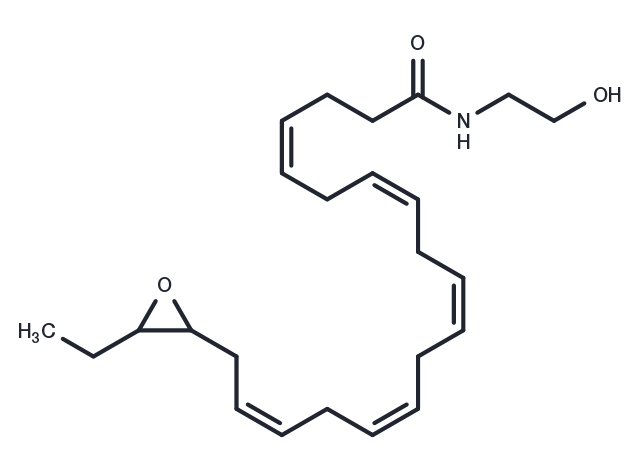Powder: -20°C for 3 years | In solvent: -80°C for 1 year


(±)19(20)-EDP ethanolamide is an ω-3 endocannabinoid epoxide and cannabinoid (CB) receptor agonist (EC50s = 108 and 280 nM for CB1 and CB2, respectively). It is produced through direct epoxygenation of docosahexaenoyl ethanolamide by cytochrome P450 (CYP) epoxygenases. (±)19(20)-EDP ethanolamide (25 μM) reduces the viability of 143B metastatic osteosarcoma cells. It decreases the production of IL-6 and increases the production of IL-10 when used at concentrations ranging from 2.5 to 10 μM in BV-2 microglia stimulated by LPS and decreases LPS-induced cytotoxicity when used at concentrations ranging from 5 to 10 μM. It also decreases nitrite production when used at a concentration of 7.5 μM, an effect that can be partially reversed by the CB2 receptor antagonist AM630 and the PPARγ antagonist GW 9662 . (±)19(20)-EDP ethanolamide induces vasodilation of isolated preconstricted bovine coronary arteries (ED50 = 1.9 μM) and reduces tube formation by human microvascular endothelial cells (HMVECs) in a Matrigel assay.

| Pack Size | Availability | Price/USD | Quantity |
|---|---|---|---|
| 25 μg | 35 days | $ 98.00 | |
| 50 μg | 35 days | $ 195.00 | |
| 100 μg | 35 days | $ 363.00 | |
| 500 μg | 35 days | $ 1,600.00 |
| Description | (±)19(20)-EDP ethanolamide is an ω-3 endocannabinoid epoxide and cannabinoid (CB) receptor agonist (EC50s = 108 and 280 nM for CB1 and CB2, respectively). It is produced through direct epoxygenation of docosahexaenoyl ethanolamide by cytochrome P450 (CYP) epoxygenases. (±)19(20)-EDP ethanolamide (25 μM) reduces the viability of 143B metastatic osteosarcoma cells. It decreases the production of IL-6 and increases the production of IL-10 when used at concentrations ranging from 2.5 to 10 μM in BV-2 microglia stimulated by LPS and decreases LPS-induced cytotoxicity when used at concentrations ranging from 5 to 10 μM. It also decreases nitrite production when used at a concentration of 7.5 μM, an effect that can be partially reversed by the CB2 receptor antagonist AM630 and the PPARγ antagonist GW 9662 . (±)19(20)-EDP ethanolamide induces vasodilation of isolated preconstricted bovine coronary arteries (ED50 = 1.9 μM) and reduces tube formation by human microvascular endothelial cells (HMVECs) in a Matrigel assay. |
| Molecular Weight | 387.564 |
| Formula | C24H37NO3 |
| CAS No. | 2123485-34-5 |
Powder: -20°C for 3 years | In solvent: -80°C for 1 year
DMF: 50 mg/mL
Ethanol:PBS(pH 7.2) (1:1): 0.5 mg/mL
DMSO: 50 mg/mL
Ethanol: 50 mg/mL
You can also refer to dose conversion for different animals. More
bottom
Please see Inhibitor Handling Instructions for more frequently ask questions. Topics include: how to prepare stock solutions, how to store products, and cautions on cell-based assays & animal experiments, etc.
(±)19(20)-EDP Ethanolamide 2123485-34-5 19(20)-EDP Ethanolamide (±)19(20)EDP Ethanolamide (±)19(20) EDP Ethanolamide inhibitor inhibit
